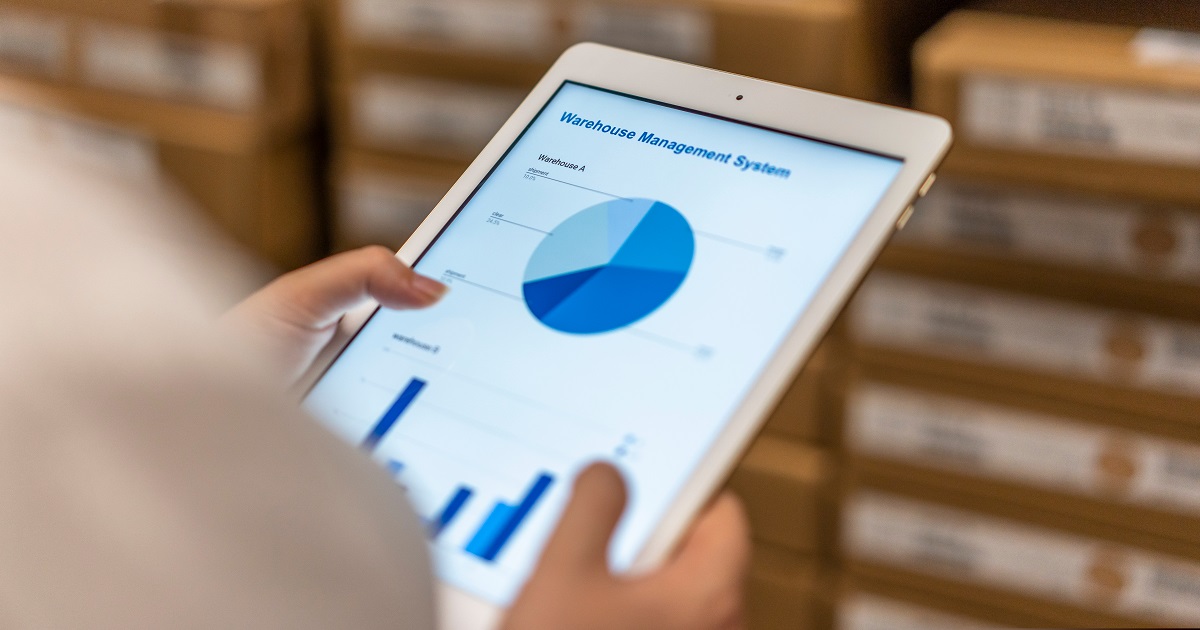
Warehousing and Distribution
Article | June 16, 2023
Enhance operational efficiency by implementing industry-approved methods for multi-channel inventory management. Taking a holistic approach to control inventory helps multiple sales channels grow.
Multi-channel inventory management is a crucial aspect of the supply chain process that ensures the goods are available to customers through different sales channels. However, with growing penetration of ecommerce technologies and the increasing complexity of supply chain networks, managing inventory across multiple channels has become daunting for businesses. The ability to accurately track inventory levels, ensure stock availability across channels, and optimize fulfillment processes has become critical to achieve success in today's competitive business landscape.
Managing inventory across multiple channels require real-time visibility and tracking of inventory levels which further streamlines the complex process. Inaccurate inventory data can lead to stockouts, overstocking, and lost sales, negatively impacting the business's bottom line. To combat these challenges, businesses must implement a robust multi-channel inventory management system to track inventory across all channels, synchronize stock levels, and automate order fulfillment processes.
An inventory management system can offer businesses a consolidated view of inventory at various locations, such as warehouses, stores, and even online channels. An organized approach is crucial while managing multi-channel inventory or keeping track of moving inventory. Implementing an effective inventory management procedure, managing multi-channel inventory becomes more streamlined and simplified, as well as provides a comprehensive overview.
In addition, as businesses continue to expand their sales channels, multi-channel inventory management has become a vital component of supply chain management. By adopting best practices in multi-channel inventory management, businesses can ensure on-demand access, accurate inventory data, and seamless order fulfilment processes. Additionally, implementing the right procedures will allow organizations to observe an increase in customer satisfaction and experience significant business growth.
The article takes an in-depth look at key benefits, potential challenges, procedural considerations, and the significance of multi-channel inventory management. It delves into the impact of this approach on supply chain performance while providing valuable insights into best practices.
1. Centralize Inventory Management Process
Centralizing multi-channel inventory helps manage supply chain businesses across various channels and locations. Businesses can gain better visibility and control over their inventory processes by consolidating inventory data. However, centralizing inventory management is not without its challenges. One of the major obstacles faced by organizations is ensuring the accuracy and consistency of data across different locations and channels.
Another barrier is integrating various inventory management tools and technologies into a single system. Despite these challenges, centralizing inventory management offers significant benefits, including improved efficiency and reduced costs. In addition, businesses can leverage cloud-based inventory management software and standard operating procedures to centralize and optimize inventory management processes effectively.
2. Adopt Lean Inventory Management Approach
The lean inventory management approach is adequate for managing multi-channel inventory in supply chain businesses. This approach involves reducing excess inventory and only stocking items in demand. While implementation of the approach is complex due to the need for accurate demand forecasting and inventory tracking, it offers multiple advantages, such as reduced inventory carrying costs, improved cash flow, and increased customer satisfaction. To implement a lean inventory management approach in the supply chain business, follow these steps:
Conduct inventory analysis
Categorize items based on value and demand
Implement just-in-time (JIT) replenishment
Leverage forecasting tools
Establish cycle counting and monitoring procedures
Strive for continuous process improvement
This approach helps businesses achieve better inventory accuracy, increase operational agility, and meet customer demands across multiple channels.
3. Utilize ABC Inventory Analysis
ABC inventory analysis is a widely used best practice for multi-channel inventory management in the supply chain. This method categorizes inventory based on its level of importance to the business. ABC inventory analysis categorizes goods into A, B, and C categories based on their impact on overall inventory cost. Category A consists of the most valuable products, category B includes items that fall in between, and category C covers small transactions that are vital for overall profit but have less individual impact. Supply chain businesses can prioritize their resources and make informed decisions by focusing on high-value inventory.
However, implementing this method can be challenging, especially when dealing with extensive inventory data. To successfully address challenges associated with implementing ABC inventory analysis for multi-channel inventory management, businesses must focus on accurate data classification, utilization of advanced analytics tools, and fostering effective team collaboration.
4. Optimize Order Management Process
Optimizing order management involves automating and streamlining order fulfilment for efficient and accurate processing across sales channels. The process ensures optimal inventory control, minimizes fulfilment time, and enhances customer satisfaction, providing a competitive advantage. Aligning inventory levels with actual demand prevents overstocking and reduces holding costs. Additionally, businesses can efficiently allocate inventory from various sources to fulfil orders, reducing the need for excess storage and transportation. The optimization is achieved by adopting automation, system integration, and data analysis. In addition, comprehensive multi-channel order management system offers multiple benefits, including native e-commerce integrations, flexible order fulfilment options, multi-location inventory management, integrated POS capabilities, data-driven inventory planning, and workflow automation, among others.
5. Integrate Sales Channels
Integrating sales channels provides businesses with a unified view of inventory, sales, and customer data, enabling informed decision-making based on real-time information. It helps accurately track products across channels as well as adjust inventory levels based on individual selling rates. The process involves synchronizing channels through a centralized system, ensuring seamless data flow and consistent product information. It includes setting up API integrations, mapping inventory, and conducting thorough testing for smooth order processing. To implement the integration, businesses must utilize technology solutions like inventory management software and enterprise resource planning (ERP) systems. Additionally, it establishes clear communication channels among teams managing different sales channels.
6. Set Cross-Channel Metrics
Cross-channel metrics measure and analyze each sales channel's performance, including online & offline sales, and identify areas for improvement. To set cross-channel metrics for multi-channel inventory, businesses must identify relevant metrics, establish benchmarks, and regularly monitor and evaluate performance. Implementing cross-channel metrics allows businesses to make data-driven decisions based on actual performance rather than relying on assumptions or incomplete data. In addition, supply chain businesses can leverage technology solutions, such as cloud-based inventory management software, to manage and consolidate their data sources effectively. Enforcing cross-channel metrics in multi-channel inventory management helps overcome several challenges, such as lack of visibility across sales channels, difficulty in identifying slow-moving products, and inefficiencies in resource allocation.
7. Automate Supply chain
Automating the supply chain and implementing advanced software systems helps businesses to optimize supply chain processes. Automation reduces manual errors, enhances efficiency, and improves overall productivity. It enables real-time inventory tracking, seamless order processing, and accurate demand forecasting. Businesses can easily overcome manual inefficiencies, bottlenecks, and data discrepancies by automating the supply chain process. The process includes integration of automation tools like inventory management software, order management systems, and warehouse management systems. The systems integrate with sales channels, suppliers, and logistics partners to automate order processing, inventory tracking, and shipment management tasks. Ultimately, businesses achieve better inventory control, faster order fulfilment, and increased customer satisfaction by automating supply chain operations.
Final Thoughts
As the supply chain market evolves, businesses must adopt innovative approaches for multi-channel inventory management. Incorporating additional sales channels into conventional brick-and-mortar operations presents a valuable opportunity to expand customer reach, boost sales, and enhance the overall customer experience. To effectively implement multi-channel sales and inventory management within a retail organization, acquiring a robust retail management system capable of efficiently monitoring inventory levels and facilitating business growth becomes essential. The adoption of an effective system can assist businesses to ensure seamless inventory control and propel sustained success in the competitive market.
Read More

Warehousing and Distribution
Article | July 17, 2023
Improve supply chain operations with innovative inventory management best practices. Uncover the techniques for achieving exceptional supply chain performance in the B2B competitive marketplace.
Effective inventory management is critical for businesses seeking to optimize their supply chain operations and improve their warehousing & supply chain distribution efficiency. By employing demand optimization techniques, inventory management aims to strike the right balance between meeting current and anticipated future demand while minimizing unnecessary inventory costs. Organizations that maintain optimal inventory levels can mitigate challenges associated with inventory, such as overstocking and stockouts.
In supply chain management, inventory optimization is vital, as it directly impacts organization’s ability to thrive. For any enterprise selling products, the effective management of goods is essential. Without adequate stock levels for sales or fulfilling customer orders, revenue generation and overall income can be severely hindered. Inefficient inventory management, leading to stock shortages, can create stumbling blocks for businesses. Conversely, improper stock tracking resulting in excess inventory can strain financial resources. As these issues compound, it further contributes to inventory imbalances, eventually leading to bottom-line losses from expired or redundant stock.
According to a recent Statista survey, 40% of the supply chain industry has already adopted advanced technologies to optimize its inventory and using networking tools.
The above data signifies the importance of optimizing and managing inventory for improved supply chain performance. Inventory analytics, typically overseen by an inventory manager, offer valuable insights that aid in understanding and enhancing inventory performance. Inventory management best practices help achieve effective inventory optimization, crucial data points encompassing products, suppliers, procurement, purchases, and sales that are meticulously tracked within the inventory management system. These data, in turn, serve as the foundation for formulating inventory metrics aimed at demand optimization.
This article explains the techniques to optimize and manage inventory with the inventory management best practices that helps overcoming challenges, addressing procedural considerations, and highlighting the significance of implementing these methods. Additionally, it explores the benefits of adopting solution for improved supply chain distribution network.
1. Implementing Standard Inventory Review Systems
To enhance supply chain operations, adopting standard inventory review system is essential, which can significantly contribute to inventory optimization efforts. Two effective methods to review systems include the continuous review system and periodic review system. In the continuous review system, fixed quantities of items are ordered in each cycle, providing a steady and consistent approach to inventory management.
On the other hand, the periodic review system involves collecting products at predetermined intervals, considering the inventory levels at that specific moment. Embracing these standardized review systems empowers businesses to streamline inventory processes, maintain optimal stock levels, and improve overall supply chain efficiency.
2. Streamline Stocktake
Supply chain operations can be improved by streamlining the stocktaking process, which involves meticulously counting and managing inventory. A well-structured stocktake procedure ensures accuracy and prevents losses by keeping staff engaged and focused.
To achieve accuracy and earn profits, businesses must:
Schedule stocktakes strategically to minimize disruption in regular business operations.
Prioritize cleaning and organizing the stockroom before the stocktake to facilitate efficient counting.
Clearly define the item count and the counting methods to eliminate guesswork.
Conduct comprehensive stock counts, leaving no room for assumptions.
By implementing these measures, businesses can optimize inventory management, identify discrepancies promptly, and maintain precise stock records. The streamlined stocktake process contributes to smoother supply chain operations, reduces inventory-related errors, and enhances overall productivity and profitability.
3. Utilize Cloud-Based Inventory Management System
Transitioning from Excel inventory management to a cloud-based inventory management system is critical to enhancing supply chain operations. It is considered one of the most used inventory control best practices. Unlike locally-installed applications, cloud-based software offers numerous advantages, enabling businesses to pay for essential features and effortlessly upgrade as needs evolve. Companies can efficiently manage costs with a predictable subscription fee tailored to feature requirements and team size. Seamless upgrades become hassle-free as business growth justifies a move to a more robust platform, ensuring scalability.
Additionally, cloud technology provides continuous support, ensuring smooth operations and quick issue resolution. With a dedicated support team on standby, businesses can focus on optimizing inventory management, managing warehouse automation, and driving overall productivity. Embracing cloud-based inventory management is a business-changing decision that unlocks increased agility, accessibility, and cost-effectiveness for long-term success.
4. Implement Adequate Quality Control Practices
Enhancing supply chain operations requires the implementation of robust quality control practices. Accurate quality control processes play a pivotal role in maintaining inventory quality, directly impacting customer satisfaction and business growth.
Effective steps include developing comprehensive checklists, outlining stock-taking procedures, followed by standard operating procedures to qualify or disqualify products with effective warehouse management systems. By adhering to these protocols, businesses can prevent issues of overstocking or understocking, ensuring customers receive only appropriate merchandise.
Companies can strengthen their reputation, increase operational efficiency, and cultivate lasting customer loyalty through this inventory optimization best practice. The seamless integration of quality control practices into the supply chain fosters a thriving business environment built on excellence and customer-centricity.
5. Preparing Well Planned Inventory Budget
A well-structured inventory budget is one of the industry-used inventory management best practices to enhance logistics distribution and supply chain processes. Managers commonly utilize an annual inventory budget, meticulously prepared before procuring inventory. The budget is designed to encompass the total cost of ownership for the upcoming accounting period, encompassing materials cost, fixed operational expenses, transportation and logistics charges, redistribution costs, and other miscellaneous expenses impacting the inventory's total cost of ownership. By crafting a comprehensive inventory budget, businesses gain financial clarity, optimize resource allocation, and ensure efficient inventory management throughout the year. A well-planned budget empowers informed decision-making, minimizing financial risks and driving overall supply chain success.
6. Carrying Safety Stock Inventory
Operations in the supply chain require safety stock inventory – a strategically maintained surplus of inventory to protect against market demand and lead time fluctuations. By implementing safety stock, businesses can avoid revenue loss, customer attrition, and declining market share that may arise in its absence.
Safety stock is vital with the advantages it offers:
Protection against sudden surges in demand.
Prevention of stockouts, ensuring uninterrupted customer service.
Compensation for inaccuracies in market forecasts.
A buffer for longer-than-expected lead times, averting production delays.
Incorporating safety stock as a fundamental inventory management best practice empowers companies to achieve operational supply chain resilience, optimize customer satisfaction, and maintain a competitive edge in the dynamic market landscape.
7. Optimize Inventory Turnover Rates
Optimizing inventory turnover rates is a critical metric that frequently measures inventory sold or used within a specific timeframe, typically a year. Calculating turnover rates provides valuable insights into market demand, identifies obsolete stock, and guides inventory management decisions.
Inventory turnover can be improved through various strategies, such as experimenting with pricing to attract more customers and boost sales, liquidating obsolete stock to free up capital and storage space, forecasting customer demand accurately to maintain optimal inventory levels, and redistributing inventory among warehouses for better stock availability. By optimizing inventory turnover rates, businesses can reduce carrying costs, minimize stock obsolescence, and enhance overall supply chain efficiency, as well as gaining competitive advantage in the market.
“It’s been my observation that the business world has a weak understanding of inventory management and control. They are trained shallowly, and sometimes they apply only shallow experience to their practices. Sometimes, that works out great. In my 30 years of experience, however, I have seen that a lot of money can be saved by training and managing inventory control in-depth.”
-Inventory Control Expert Dr. Pyke
Final Thoughts
Adopting advanced inventory management best practices is crucial for supply chain optimization in the competitive B2B environment. Standardized inventory review systems and streamlined stocktakes optimize control and accuracy, minimizing disruptions. Cloud-based inventory management offers scalability and continuous support, facilitating data-driven decisions. Adequate quality control ensures inventory quality, driving customer loyalty. Well-planned budgets lead to financial clarity and precise resource allocation. Safety stock inventory and optimized turnover rates fortify businesses against uncertainties, boosting efficiency and profitability. By embracing these practices, logistics professionals can enhance supply chain potential, achieve lasting success, and gain a competitive advantage in the market. With a data-focused approach, these strategies pave the way for streamlined operations, stronger customer relationships, and sustained growth.
Read More

Management
Article | June 21, 2023
Warehouse logistics is the heart of any supply chain operation, assimilating and dispatching goods to ensure availability and timely delivery. With more consumers turning to e-commerce, it’s important for businesses of all sizes to bolster the supply chain to handle the e-commerce business model. According to research conducted by BigCommerce, the top three factors that influence consumers’ online purchasing decisions are convenience, cost and free shipping. In fact, the National Retail Federation (NRF) found that 75% of consumers expect delivery to be free even for orders under $50.
Read More

Freight
Article | March 21, 2022
Even though there are distinct differences between demurrage, detention and port charges, many are still oblivious to these differences and there have been several questions on this blog relating to these charges.
This article is about how demurrage, detention, and port charges work.
International Trade and CostsWhen it comes to international trade, majority of the buyers and sellers use Incoterms to decide what each other’s responsibilities and liabilities are in terms of the business, especially related to costs.
Generally, there is very little room to manoeuvre in terms of additional and unbudgeted costs incurred on the shipment and therefore in their own interest it is important that the buyers and sellers take necessary precautions to ensure that all known costs relating to the business are discussed and finalised before the shipment commences.
There are many entities involved in the process of shipping a container from Point A to Point B, each with their own cost component, all of which have to be covered either by the seller or the buyer.
Demurrage, detention and port charges are just some of these costs that may be applicable in a shipment.
While some of the port charges are valid and unavoidable, demurrage, detention and some of the port charges (like port storage, early arrival, late arrival, amendment, shifting etc) are entirely avoidable if everyone in the chain follows the process that they need to follow.
What are port charges?
Port charges, as the name suggests are a set of charges levied by the port or terminal which the container passes through.In terms of container shipments, port charges may include but not limited to below :
Terminal Handling Charge (THC)
Is quite simply the charge levied by the port for the loading and discharging of a container from the ship.. THC differs from port to port, terminal to terminal around the world and is charged both by the load port and discharge port.If the cargo is transhipped anywhere along the route, then the transhipment port also charges this THC but that is paid by the shipping line directly to the port and this quantum is usually included in the ocean freight charged by the line.
Early Arrival Charge
A charge levied by some of the ports/terminals for a container that arrives in the terminal BEFORE the stacks into which it is to be taken has been opened.. Early arrival can happen due to various reasons like a container missed the stacks for the previous vessel narrowly, but since the container is packed, it needs to be taken to the port, The acceptance of containers prior to the stacks/gate open is at the discretion of the Port/Terminal Operator and on the circumstances surrounding the operation of the vessels.
Late Arrival Charge
A late arrival charge is a charge levied by the port for a container that arrives in the terminal AFTER the stacks into which it is to be taken has been closed.. This could be due to delays in documentation, packing delays, inspection, trucking delays and many other situations.The acceptance of containers after the closing of stacks/gate is at the discretion of the Port/Terminal Operator and on the circumstances surrounding the operation of the vessels and if the containers can be accepted without disrupting the schedule of the vessel and ports.
Stuffing/Destuffing of Containers
Some ports/terminals allow the stuffing (packing)/de-stuffing (unpacking) of the containers within the port area and charge customers based on the port tariff.This activity may happen at ports that provide CFS services and allow containers to be packed or unpacked in the port or due to some mistakes when the cargo was originally packed – say incompatible hazardous cargoes packed together.Depending on the port/terminal/country, the port charges may be charged directly to the customer (importer or exporter) or to the shipping line, who in turn will charge this to the customer.
Of course, this is not the full list of port charges but these charges have been mentioned as it relates to the subject under discussion,Demurrage and DetentionWhile some of these port charges may be unavoidable, demurrage and detention charges on the other hand are avoidable charges, but in a lot of cases due to mishandling, miscommunication, misunderstandings and not following the proper protocols, these charges occur..When they do occur, these charges may create quite a financial impact on the whole business and sometimes these costs could be so prohibitive that some customers abandon their cargoes at the destination due to these costs.
Although the most common market practice is to combine demurrage and detention, there are several cases where these are charged separately, and therefore it is important to know the difference between demurrage and detention.
Read More